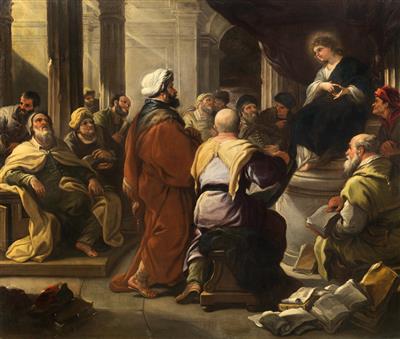Luca Giordano

(Naples 1634–1705)
Christ among the Doctors,
oil on canvas, 120 x 138.5 cm, framed
Provenance:
Heim Gallery, London (1975);
Private collection, Rome
Exhibited:
London, Heim Gallery, Paintings by Luca Giordano. Summer exhibition, 20 June – 29 August 1975, cat. no. 7 (as Luca Giordano)
Literature:
Paintings by Luca Giordano. Summer exhibition, ed. by Heim Gallery, London 1975, cat. no. 7 (as Luca Giordano);
O. Ferrari/G. Scavizzi, Luca Giordano: l’opera completa, Naples 2000, p. 278 cat. no. A177, illustrated p. 557 fig. no. 258 (as Luca Giordano)
The present painting is registered in the Fototeca Zeri as Luca Giordano (no. 51339).
The episode represented in the present painting is taken from the Gospel according to Luke (2: 41-50) wherein Joseph and Mary having lost sight of the young Jesus in Jerusalem, found him in the Temple, contentedly interrogating the Doctors of the church on issues of theology.
The compostion is organised around two focal points: the young Christ seated high on the right, and the columns of the temple opposite, thereby referring to the juxtaposition of the new faith with the old. A crowd of church Doctors is gathered around, some listening with astounded admiration, while others are shown in discussion as they compare Christ’s word with the sacred scriptures.
Luca Giordano represented the subject of Christ among the Doctors on several occasions over the course of his long and prolific career, and most particularly at the beginning of the 1650s. A significant version of the subject is conserved in the Galleria Nazionale of Palazzo Corsini, Rome (inv. no. 394)..
The present painting is considered to be from an earlier moment in Giordano’s career, and has been dated by Ferrari and Scavizzi to circa 1664-65 (see literature), shortly before the artist’s departure for Venice where he was to execute the Assumption for Santa Maria della Salute which is signed and dated 1667.
Luca Giordano probably gained formative experience in the Neapolitan studio of Jusepe de Ribera, whose naturalistic models apparently influenced the young painter. However, his acquired sobriquet Fa Presto, has given succour to the idea of the self-educated genius. Later, his painting style loosened-up, employing a richer palette and a new expressive freedom that derived from his many formative travels to Rome, Venice and Parma. He executed prestigious commissions in Naples, as well as at Venice, Padua and Florence where, during the 1680s he frescoed the dome of Santa Maria del Carmine and the Salone of Palazzo Riccardi. Subsequently Luca Giordano was called to Spain where he remained for a decade and executed decorative cycles in Toledo cathedral and the Escorial.
Specialist: Mark MacDonnell
 Mark MacDonnell
Mark MacDonnell
+43 1 515 60 403
mark.macdonnell@dorotheum.at
09.06.2020 - 16:00
- Realized price: **
-
EUR 75,300.-
- Estimate:
-
EUR 60,000.- to EUR 80,000.-
Luca Giordano
(Naples 1634–1705)
Christ among the Doctors,
oil on canvas, 120 x 138.5 cm, framed
Provenance:
Heim Gallery, London (1975);
Private collection, Rome
Exhibited:
London, Heim Gallery, Paintings by Luca Giordano. Summer exhibition, 20 June – 29 August 1975, cat. no. 7 (as Luca Giordano)
Literature:
Paintings by Luca Giordano. Summer exhibition, ed. by Heim Gallery, London 1975, cat. no. 7 (as Luca Giordano);
O. Ferrari/G. Scavizzi, Luca Giordano: l’opera completa, Naples 2000, p. 278 cat. no. A177, illustrated p. 557 fig. no. 258 (as Luca Giordano)
The present painting is registered in the Fototeca Zeri as Luca Giordano (no. 51339).
The episode represented in the present painting is taken from the Gospel according to Luke (2: 41-50) wherein Joseph and Mary having lost sight of the young Jesus in Jerusalem, found him in the Temple, contentedly interrogating the Doctors of the church on issues of theology.
The compostion is organised around two focal points: the young Christ seated high on the right, and the columns of the temple opposite, thereby referring to the juxtaposition of the new faith with the old. A crowd of church Doctors is gathered around, some listening with astounded admiration, while others are shown in discussion as they compare Christ’s word with the sacred scriptures.
Luca Giordano represented the subject of Christ among the Doctors on several occasions over the course of his long and prolific career, and most particularly at the beginning of the 1650s. A significant version of the subject is conserved in the Galleria Nazionale of Palazzo Corsini, Rome (inv. no. 394)..
The present painting is considered to be from an earlier moment in Giordano’s career, and has been dated by Ferrari and Scavizzi to circa 1664-65 (see literature), shortly before the artist’s departure for Venice where he was to execute the Assumption for Santa Maria della Salute which is signed and dated 1667.
Luca Giordano probably gained formative experience in the Neapolitan studio of Jusepe de Ribera, whose naturalistic models apparently influenced the young painter. However, his acquired sobriquet Fa Presto, has given succour to the idea of the self-educated genius. Later, his painting style loosened-up, employing a richer palette and a new expressive freedom that derived from his many formative travels to Rome, Venice and Parma. He executed prestigious commissions in Naples, as well as at Venice, Padua and Florence where, during the 1680s he frescoed the dome of Santa Maria del Carmine and the Salone of Palazzo Riccardi. Subsequently Luca Giordano was called to Spain where he remained for a decade and executed decorative cycles in Toledo cathedral and the Escorial.
Specialist: Mark MacDonnell
 Mark MacDonnell
Mark MacDonnell
+43 1 515 60 403
mark.macdonnell@dorotheum.at
|
Buyers hotline
Mon.-Fri.: 10.00am - 5.00pm
old.masters@dorotheum.at +43 1 515 60 403 |
| Auction: | Old Master Paintings |
| Auction type: | Saleroom auction |
| Date: | 09.06.2020 - 16:00 |
| Location: | Vienna | Palais Dorotheum |
| Exhibition: | 02.06. - 09.06.2020 |
** Purchase price incl. charges and taxes
It is not possible to turn in online buying orders anymore. The auction is in preparation or has been executed already.
